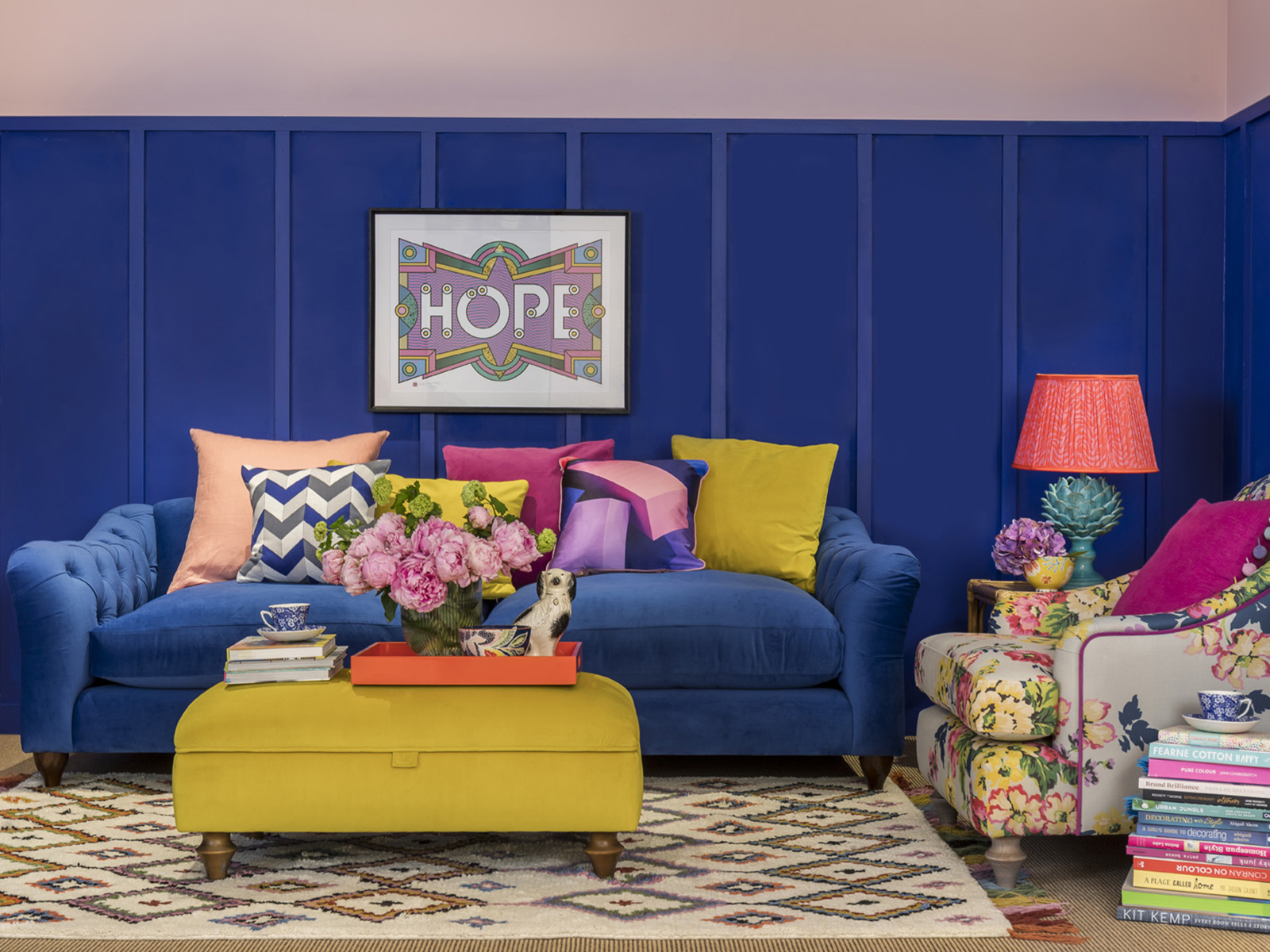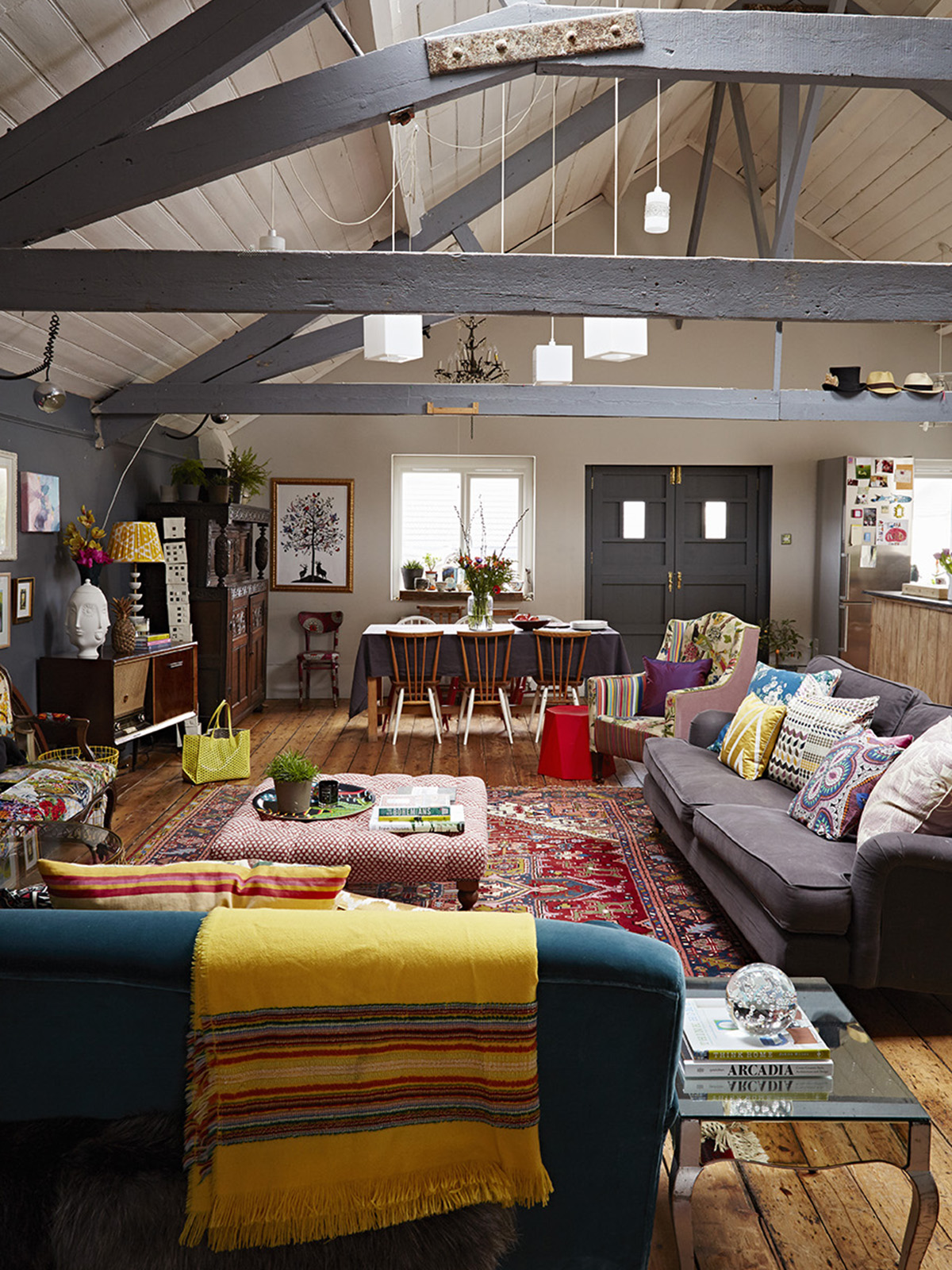The Great Indoors Podcast S2 Episode 2 Show Notes

Back on the podcast and Kate and I are already going head to head on some hot decorating topics. Here you’ll find the notes, links and some useful illustrations on points discussed on episode 2, series 2 of The Great Indoors Podcast.
Should White Paint be banned?
Kate and I discuss why we feel brilliant white paint is one of the worst colours to decorate with and when you can use it but why we think it should be avoided.

The room I designed that had deep blue walls and a pale pink colour above the picture rail and across the ceiling. Raffles sofa by Dfs
- Brilliant white is a cold white with a blue hue. It will make dark rooms feel flat and depressing. Opt for a warm white in North facing rooms
- Bright white is only really suitable in rooms with plenty of warm south-facing light, as that will add the light, shade and interest.
- Don’t just automatically opt for the white paint tin when decorating the skirting, dado rails, picture rails and architraves. Choose a colour that will work with the colour scheme, this will not only give the room a modern feel it will also create a sense of space.
- Painting the skirting the same colour as the wall will help elongate the wall and give the illusion the ceiling is higher.

In my hallway and landing, I have painted all the woodwork and doors in the same colour as the walls to enhance the sense of space and add a contemporary look
- Painting the ceilings in the same colour as the walls or in a complementing shade will not only keep the scheme cohesive, it can make the walls appear taller – so it’s not so obvious where the walls end and the ceiling begins.
- If white is the considered choice of colour for your ceiling – it works if it is reflecting elsewhere, such a white floor.
- Unless you have very attractive or designer radiators, paint them the same colour as the wall so they don’t stand out and become an irritating eyesore.
- Bright white can help draw the eye positively to a feature in the room, like a stunning staircase.
Conscious shopping
- There’s nothing more sustainable than not buying at all, so first off, shop at home – rearrange furniture and re-style the objects you already have to give your scheme a new lease of life.
- Take a cue from the Scandinavian way of life and change with the seasons. Changing cushions and accessories from season to season can make you feel like you’ve had a mini re-decoration and things like cushions are easy to store!
- Upcycling (sorry for using the dirty word Kate) but not only is it sustainable but it’s cheap. If you’re bored with something, recover, re-upholster or paint it.
- Mindful shopping, think about it before you grab the credit card and ask yourself, do I need it, will I love it forever and have I got a space for it?
- Cut down on one use plastics. You can get a subscription from Bam & Boo for bamboo toothbrushes. Can you believe a whopping 3.6 billion plastic toothbrushes are used and discarded worldwide every year!

Sideboard made my eco designer maker Ted Jeffries
- Conscious shopping is not just about waste you also need to think about where it comes from. Check out Aerende they sell products by people who have social disadvantages, for example, organic linen tea towels made by refugee women, wooden spoons made by people with learning difficulties. It’s also about who’ll benefit if you buy from a particular place.
- Buy to last – initial cost might be higher but the better the quality the longer it will last!
- Ted Jeffries, is a designer-maker with a passion for British manufacture. When you’re buying directly from the maker – there isn’t the retail mark-up as you would find on the high street so it might not be as expensive as you may think!
- My blog post on Conscious shopping and my collaboration with Etsy can be read here
Open plan spaces
- Architect Frank Lloyd Wright was prominent in the 1930s and was the first to advocate open plan living based around the idea that the kitchen was the hub of the home with other spaces leading off it. The then ‘housewife’ could be a hostess in her own home rather than banished to the kitchen behind closed doors.
- When knocking down walls you will inevitably encounter some design dilemmas, the main being flooring – I am often asked can you use more than one different type of flooring? Using different types of flooring can help zone the space, tiles in the kitchen, floorboards in the dining room. However using the same floor throughout brings cohesion.
- Use rugs, pendant lights, and arrange furniture in such a way to zone different areas.
- Always go for the biggest rug you can afford, so all the living room furniture can sit on the rug
- Plan your downlighters to highlight specific areas or surfaces (island, dining table, console table) in the room and avoid a grid of downlighters.
- Broken plan living means creating barriers in the room, like islands, half walls and screens.
We hope you are loving our podcast. If you haven’t already please do subscribe, rate and leave us a review. We read every one! You can listen to the podcast on any platform, all links are here. A huge thanks to our sponsor Dfs for sponsoring this podcast and to our producer Kate Taylor.
















 proof that your landing de
proof that your landing de
